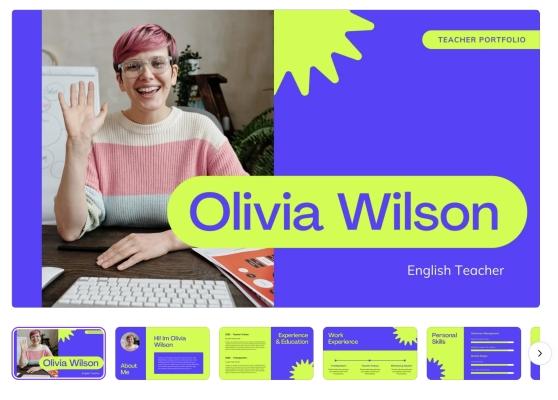
A teacher portfolio template from Canva.
Whether you are preparing for tenure or applying for a transfer to a new school through the Open Market Transfer system, compiling a digital teaching portfolio can be a wise move.
Digital portfolios are easily shareable; you can send a link to an interested party and/or add it to your resume. If your materials are already online, it’s quicker to compile a digital portfolio and easier to update it. Moreover, a digital portfolio travels with you if you switch schools.
A teaching portfolio consists of artifacts that highlight your expertise and experience as a teacher, such as lesson plans, presentations, class newsletters, awards or honors, positive evaluations, projects, published writing, course syllabuses, workshops attended, certifications and selected student work (with names and identifying characteristics removed).
Choose items that reflect well on your practice but that also tell a story about the teacher you are and your pedagogical philosophy. Be selective and keep things streamlined; don’t include multiple examples of the same type of artifact. Of course, include only original materials you personally had a hand in developing.
To make an effective presentation of your teaching practice, organization is key. Should you arrange items by theme, subject area or topic? That decision is up to you, but whatever you choose, have an obvious structure that is easy to navigate. Feel free to craft an elegant design, but not at the expense of clarity. Consider how others will view and interact with your portfolio — is it easy to find examples of your best work? Ask a friend or colleague for feedback before you share your portfolio with the world.
Though we usually create portfolios to show our work to others, they are also tools we can use ourselves. Looking back from a distance naturally forces us to self-reflect and consider why certain lessons and projects went well, but also how to improve them in the future. Your portfolio can also serve as your own digital archive that you can draw upon to reuse or revamp existing teaching materials for a new set of students.
There are several apps and websites you can use to build a digital portfolio. Some have templates built in, which helps tremendously if you’re creating a portfolio for the first time.
If you’re already using Google Workspace, you may want to consider creating a folder in Google Drive or designing a Google Site to serve as your digital portfolio, but remember to use a personal Gmail account so your work is always accessible to you. Make links publicly available and make copies of documents in Google Classroom that may not be shareable, too.
Canva Education has templates and stylish designs for creating portfolios, along with templates you can customize. It has a bit.ly web link shortener built in so you can generate a custom web address for your portfolio.
You can also create a free website on Wix. It has a portfolio builder that enables you to create your own design without learning code.
Creating a teaching portfolio can be eye-opening. When you assemble much of your teaching life in one place online, you can see clearly what you have accomplished in your career. Being able to send the entire collection in a single link makes it easy for your work to be viewed — and valued.